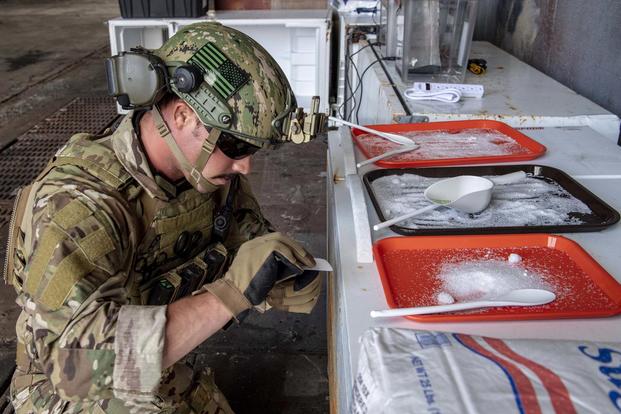Sen. Marco Rubio is the senior U.S. senator from Florida. He sits on the Senate Committee on Foreign Relations, among others.
The future of work in 21st-century America will be dominated by Science, Technology, Engineering and Mathematics (STEM) and computer science careers. To further enhance America's position as an innovative, globally competitive leader, job creators should look to our nation's veterans to fill these critical roles.
Our veterans are uniquely positioned to excel in STEM and computer science roles. Cadets across our service academies are educated in the STEM fields in order to be prepared to meet the demands of the military. While in service, the magnitude of unique training and skills -- in cybersecurity, cryptology, avionics, weapons training, nuclear physics and medicine, to name a few -- our active-duty military members receive can be well integrated into a variety of civilian STEM jobs.
In the U.S. Navy, for example, Explosive Ordnance Disposal (EOD) technicians are trained across the spectrum of STEM fields. Navy EOD training begins at the Naval Diving and Salvage Training Center (NDSTC) in Panama City Beach, Florida. In this section of training, students learn diving medicine and diving physics. Diving operations require mathematics to calculate a diver's air endurance and bottom time, and students learn to recognize neurological deficits associated with decompression sickness and arterial gas embolism symptoms.
Following NDSTC, students report to Naval School Explosive Ordnance Disposal (NAVSCOLEOD) at Eglin Air Force Base, Florida, to begin the core phase of EOD training. At NAVSCOLEOD, EOD students calculate explosive safety measures, such as explosive blast overpressure and hazardous fragmentation distances. In the Improvised Explosive Devices (IED) division, students learn robotics operation, electrical and mechanical theory, and operational risk management to remotely render-safe IEDs.
After IED division, students learn chemical and biological agent composition, hazards, protective measures and decontamination procedures. The next block of training, Nuclear Division, includes nuclear physics and radiation stay-time calculations in relation to nuclear weapons. The final phase of Navy EOD training, Underwater Division, puts Navy EOD students back in the water, where they must apply previously learned land-based EOD skills to the aquatic environment. Upon graduation, Navy EOD students receive the apprenticeship equivalent of the EOD trade, and will continue their progression toward becoming senior and master EOD technicians over the coming years.
Unfortunately, this first-hand training does not guarantee a job post-service. While you would think that returning home after serving our country would open up several doors to a successful new career, even in 2019, many veterans continue to struggle with transitioning into these next-generation civilian jobs.
By 2022, projections show that there will be more than nine million STEM jobs. During this same time period, more than 1.5 million members of the U.S. armed forces will retire from service and seek new careers. Despite the increasing opportunities available in the STEM fields, our veterans continue to face challenges to entering this critical workforce when they return home. Oftentimes, these barriers are as simple as issues with transferring military credits to college credits in order to qualify for certain jobs.
Enter the Supporting Veterans in STEM Careers Act (S. 153). Earlier this year, I was proud to join Sen. Amy Klobuchar (D-Minnesota) and Rep. Neal Dunn (R-Florida) in reintroducing this bipartisan legislation to eliminate obstacles preventing our nation's well-qualified veterans from participating in the STEM workforce by directing the federal government to enhance outreach, education and research opportunities.
First, our bill directs the National Science Foundation (NSF), in coordination with other federal agencies, to encourage veterans to study and pursue careers in STEM and computer science. Second, it requires the director of NSF to submit a veterans outreach plan to Congress. Specifically, the plan must: (1) report on NSF's existing outreach activities; (2) identify best methods to leverage existing programs to facilitate and support veterans in STEM careers and studies; and (3) include options for how NSF could track veteran participation in research and education programs, and describe current barriers to collecting such information. Third, it updates several NSF research, educational and grant programs to include veteran participation. Finally, it requires the Office of Science and Technology Policy to establish an interagency working group to coordinate federal programs for transitioning and training veterans from STEM careers, and to develop a strategic plan to address the barriers that veterans face when re-entering the workforce.
Already this Congress, the House of Representatives recognized the importance of this legislation, passing it by voice vote on Feb. 27, 2019. I look forward to working with my Senate colleagues to pass the Supporting Veterans in STEM Careers Act in the United States Senate, and ultimately get it signed into law by President Donald Trump.
Demand for STEM and computer science jobs is on the rise, and the United States should prioritize policies that utilize our well-qualified veterans returning home to fill this future workforce. We owe it to our national heroes to ensure this bipartisan legislation gets across the finish line.
From the front lines of freedom to the front of the job line, I am committed to putting our national heroes in the best position possible to become personally successful while continuing to support U.S. interests as a global technology leader. Our veterans did not hesitate to answer the call to protect our great nation, and we must do everything we can to ensure that they have the skills and opportunities they need to successfully transition into the 21st-century workforce.
-- The opinions expressed in this op-ed are those of the author and do not necessarily reflect the views of Military.com. If you would like to submit your own commentary, please send your article to opinions@military.com for consideration.















